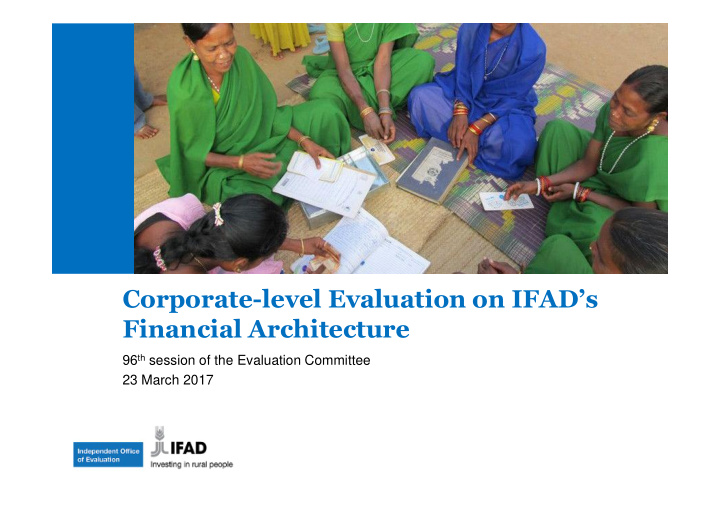



Corporate-level Evaluation on IFAD’s Financial Architecture 96 th session of the Evaluation Committee 23 March 2017
The Context • “ Double nature” of IFAD: Specialised UN Agency and IFI, focus on rural poverty reduction • Concessional arms of other IFIs are being reformed (higher leveraging of resources) • ODA increased by nearly 50% between 2004-05 and 2014. ODA total and ODA multilateral contributions slightly fell in 2015 • Evolution of Members’ contributions to IFAD replenishments IFAD 6 IFAD 7 IFAD 8 IFAD 9 IFAD 10 Members’ 0.56 0.80 1.20 1.50 1.44 contribution (US$ billion) - 2 -
Status of IFAD Loan Financing (End 2016, cumulative) • 1,149 Projects Financed; US$ 14.4 billion, of which 11.4% 10.2% 14.8% Ordinary Interm./Blended Highly Concessional Debt Sustainability Framework 63.6% - 3 -
Financial Architecture - Operational definition IFAD Policies, Strategies and Processes relating to: 1. Sources of funds (e.g. replenishments, reflows, cofinancing, sovereign borrowing, supplementary funds) 2. Use and allocation of the resources 3. Financial support instruments and their performance 4. Corporate financial management and oversight systems 5. External financial oversight system (e.g., role of GC, EB, Replenishment consultation) - 4 -
Selected milestones in IFAD’s Financial Architecture -Selected milestones Timeline Main Events 1976 Agreement Establishing IFAD 2000 IFAD participates in the Debt Initiative for HIPCs 2004 PBAS introduced 2007 Debt Sustainability Framework 2013 Revised Policies and Criteria for IFAD Financing. 2014 IFAD10 Replenishment. KfW Eur 400 million loan. 2015 • Sovereign Borrowing Framework adopted. • Grant policy revised. 2016 • Internal report of the Corporate Working Group on IFAD’s Financial Policies • Treasury model enhanced • EB approved sovereign loans from AFD for Eur 200 million 2017 IFAD11 Management’s presentation to the EB in September 5
CLE Time frame and objectives Period : 2004-2017 Objectives • To Assess: (i) performance of the financial architecture in mobilising resources; (ii) value added of IFADs financial instruments to member states;(iii) contribution to IFAD’s financial sustainability • To identify alternatives and options to strengthen IFAD’s capacity to fund rural poverty reduction programmes . - 6 -
Simplified results chain • IFAD has policies to mobilise, manage, allocate & disburse finance Inputs Inputs • IFAD has a range of financial instruments with flexible sources and modalities Outputs • COSOP & project design identify rural development and poverty reduction issues Outputs • Financial product mix is flexible and adapted to different country contexts • Financial products meet diverse needs of borrowers & enable effectively targeted interventions Outcomes Outcomes • Implementation procedures are efficient and effective • Resource mobilisation and financial product assure adequate resource stream Longer- Longer- • Effective financial products contribute to country programme performance term term • Financial sustainability of to fulfil IFAD’s mandate over the long run results results - 7 -
Evaluation Criteria • Of the financial architecture in mobilizing financial resources Relevance • Of the financial products offered to member states for the desired intervention types • Test the (implicit) assumptions • Of resource mobilization to meet IFAD’s demand for financing, including external resources for scaling up Effectiveness • Of the financial instruments to serve rural development needs • Corporate administrative cost ratios and their trends • Liquidity and other standard financial ratios. Efficiency • Treasury functions (maximizing investment profits within cash and risk constraints) • Effect of the mix of financial products, terms and Financial conditions on IFAD’s short and long term financing Sustainability • Key drivers and implications of external factors • Lessons from other comparable organizations
Data collection and analysis Analysis, triangulation and synthesis Desk review Review of comparator Organizations Management Self- Selected assessment country visits E-survey of Key Informant IFAD staff and Interview at stakeholders IFAD Quantitative data analysis - 9 -
Timeline of the evaluation April 2017 – February 2018 • Data collection and analysis • Report writing March – June 2018 • Presentation to IFAD Management on early findings • Draft Report shared with Management • Comments from Management. Draft report finalized September 2018 • Presentation of final report to the Evaluation Committee and to the Executive Board 10
Recommend
More recommend